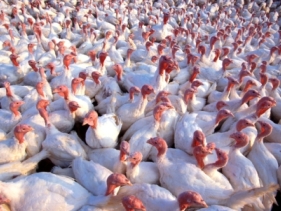Mycotoxins threaten turkey performance

Mycotoxins in rations could be more prevalent than often thought, leading to adverse effects in turkey flocks that were not normally diagnosed, suggested Andrew Robertson of Austrian nutrition company Biomin.
In particular, undetected mycotoxins could be the primary cause of unspecified intestinal problems that returned again and again after treatment with antibiotics, he claimed.
Robertson pointed out that conventional testing methods for mycotoxins only identified specific levels of free individual toxins in the feedstuff. "However, it will not give you the whole answer, because many of the masked mycotoxins we cannot really identify."
Masked mycotoxins
Masked or conjugated mycotoxins were those which were bound to soluble molecules such as glucose, starch or amino acids by the infected plant. The masking of mycotoxins was a defensive mechanism against the mycotoxin-producing fungus, in order to limit their toxic effect to the host, he explained.
Masked or conjugated mycotoxins were those which were bound to soluble molecules such as glucose, starch or amino acids by the infected plant. The masking of mycotoxins was a defensive mechanism against the mycotoxin-producing fungus, in order to limit their toxic effect to the host, he explained.
The threat from mycotoxins was increased by two further factors. One of these was the additive or synergistic effect of two or more mycotoxins together, which led to toxic effects much greater than the individual levels would suggest.
The second was their immunosuppressant effect on the bird, which could result in poorer growth or increased mortality where an infection such as E coli was present.
Dealing with these issues required a "risk assessment" approach to the use of mycotoxin treatment in animal feed, appropriate to the actual challenge.
Source: Farmers Weekly











